Basalt

Basalt

| Igneous rock | |
| Composition | |
|---|---|
| Mafic: amphibole and pyroxene, sometimes plagioclase, feldspathoids, and/or olivine. |
Basalt (US: /bəˈsɔːlt, ˈbeɪsɒlt/, UK: /ˈbæsɔːlt, ˈbæsəlt/)[1][2][3][4] is a mafic extrusive igneous rock formed from the rapid cooling of magnesium-rich and iron-rich lava[5] exposed at or very near the surface of a terrestrial planet or a moon. More than 90% of all volcanic rock on Earth is basalt.[6] Basalt lava has a low viscosity, due to its low silica content, resulting in rapid lava flows that can spread over great areas before cooling and solidification. Flood basalt describes the formation in a series of lava basalt flows.
| Igneous rock | |
| Composition | |
|---|---|
| Mafic: amphibole and pyroxene, sometimes plagioclase, feldspathoids, and/or olivine. |
Definition

Columnar basalt flows in Yellowstone National Park, USA
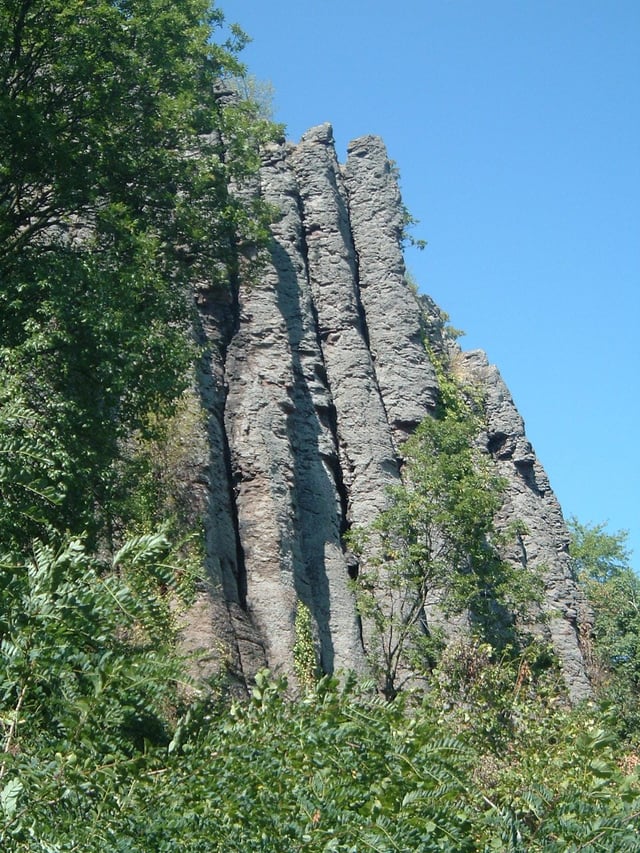
Columnar basalt at Szent György Hill, Hungary

Vesicular basalt at Sunset Crater, Arizona. US quarter for scale.
By definition, basalt is an aphanitic (fine-grained) igneous rock with generally 45–53% silica (SiO2)[7] and less than 10% feldspathoid by volume, and where at least 65% of the rock is feldspar in the form of plagioclase. This is as per definition of the International Union of Geological Sciences (IUGS) classification scheme.[8][9][10] It is the most common volcanic rock type on Earth, being a key component of oceanic crust as well as the principal volcanic rock in many mid-oceanic islands, including Iceland, the Faroe Islands, Réunion and the islands of Hawaiʻi. Basalt commonly features a very fine-grained or glassy matrix interspersed with visible mineral grains. The average density is 3.0 g/cm3.
Basalt is defined by its mineral content and texture, and physical descriptions without mineralogical context may be unreliable in some circumstances. Basalt is usually grey to black in colour, but rapidly weathers to brown or rust-red due to oxidation of its mafic (iron-rich) minerals into hematite and other iron oxides and hydroxides. Although usually characterized as "dark", basaltic rocks exhibit a wide range of shading due to regional geochemical processes. Due to weathering or high concentrations of plagioclase, some basalts can be quite light-coloured, superficially resembling andesite to untrained eyes. Basalt has a fine-grained mineral texture due to the molten rock cooling too quickly for large mineral crystals to grow; it is often porphyritic, containing larger crystals (phenocrysts) formed prior to the extrusion that brought the magma to the surface, embedded in a finer-grained matrix. These phenocrysts usually are of olivine or a calcium-rich plagioclase, which have the highest melting temperatures of the typical minerals that can crystallize from the melt.
Basalt with a vesicular texture is called vesicular basalt, when the bulk of the rock is mostly solid; when the vesicles are over half the volume of a specimen, it is called scoria. This texture forms when dissolved gases come out of solution and form bubbles as the magma decompresses as it reaches the surface, yet are trapped as the erupted lava hardens before the gases can escape.
The term basalt is at times applied to shallow intrusive rocks with a composition typical of basalt, but rocks of this composition with a phaneritic (coarser) groundmass are generally referred to as diabase (also called dolerite) or, when more coarse-grained (crystals over 2 mm across), as gabbro. Gabbro is often marketed commercially as "black granite."
In the Hadean, Archean, and early Proterozoic eras of Earth's history, the chemistry of erupted magmas was significantly different from today's, due to immature crustal and asthenosphere differentiation. These ultramafic volcanic rocks, with silica (SiO2) contents below 45% are usually classified as komatiites.
Etymology
The word "basalt" is ultimately derived from Late Latin basaltes, a misspelling of Latin basanites "very hard stone", which was imported from Ancient Greek βασανίτης (basanites), from βάσανος (basanos, "touchstone") and perhaps originated in Egyptian bauhun "slate".[11] The modern petrological term basalt describing a particular composition of lava-derived rock originates from its use by Georgius Agricola in 1556 in his famous work of mining and mineralogy De re metallica, libri XII. Agricola applied "basalt" to the volcanic black rock of the Schloßberg (local castle hill) at Stolpen, believing it to be the same as the "very hard stone" described by Pliny the Elder in Naturalis Historiae.[12]
Types
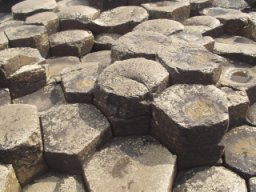
Large masses must cool slowly to form a polygonal joint pattern, as here at the Giant's Causeway in Northern Ireland
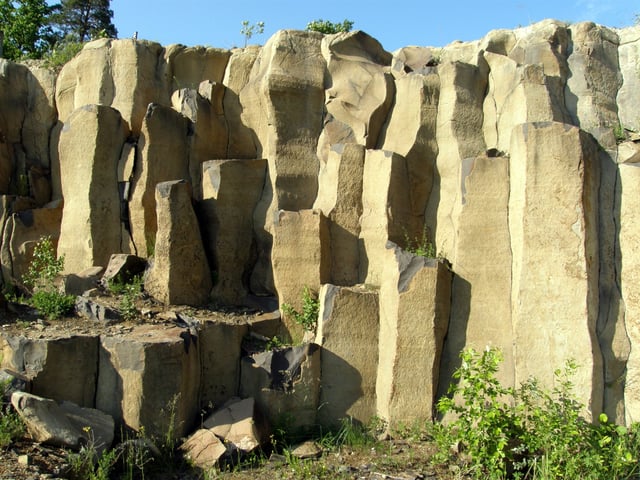
Near Bazaltove, Ukraine
Tholeiitic basalt is relatively rich in silica and poor in sodium. Included in this category are most basalts of the ocean floor, most large oceanic islands, and continental flood basalts such as the Columbia River Plateau. High and low titanium basalts. Basalt rocks are in some cases classified after their titanium (Ti) content in High-Ti and Low-Ti varieties. High-Ti and Low-Ti basalts have been distinguished in the Paraná and Etendeka traps[13] and the Emeishan Traps.[14] Mid-ocean ridge basalt (MORB) is a tholeiitic basalt commonly erupted only at ocean ridges and is characteristically low in incompatible elements.[15][16] E-MORB, enriched MORB N-MORB, normal MORB D-MORB, depleted MORB
High-alumina basalt may be silica-undersaturated or -oversaturated (see normative mineralogy). It has greater than 17% alumina (Al2O3) and is intermediate in composition between tholeiitic basalt and alkali basalt; the relatively alumina-rich composition is based on rocks without phenocrysts of plagioclase.
Alkali basalt is relatively poor in silica and rich in sodium. It is silica-undersaturated and may contain feldspathoids, alkali feldspar and phlogopite.
Boninite is a high-magnesium form of basalt that is erupted generally in back-arc basins, distinguished by its low titanium content and trace-element composition.
Ocean island basalt
Lunar basalt
Petrology

Photomicrograph of a volcanic (basaltic) sand grain; upper picture is plane-polarized light, bottom picture is cross-polarized light, scale box at left-center is 0.25 millimeter. Note white plagioclase "microlites" in cross-polarized light picture, surrounded by very fine grained volcanic glass.
The mineralogy of basalt is characterized by a preponderance of calcic plagioclase feldspar and pyroxene. Olivine can also be a significant constituent. Accessory minerals present in relatively minor amounts include iron oxides and iron-titanium oxides, such as magnetite, ulvöspinel, and ilmenite. Because of the presence of such oxide minerals, basalt can acquire strong magnetic signatures as it cools, and paleomagnetic studies have made extensive use of basalt.
In tholeiitic basalt, pyroxene (augite and orthopyroxene or pigeonite) and calcium-rich plagioclase are common phenocryst minerals. Olivine may also be a phenocryst, and when present, may have rims of pigeonite. The groundmass contains interstitial quartz or tridymite or cristobalite. Olivine tholeiitic basalt has augite and orthopyroxene or pigeonite with abundant olivine, but olivine may have rims of pyroxene and is unlikely to be present in the groundmass. Ocean floor basalts, erupted originally at mid-ocean ridges, are known as MORB (mid-ocean ridge basalt) and are characteristically low in incompatible elements.
Alkali basalts typically have mineral assemblages that lack orthopyroxene but contain olivine. Feldspar phenocrysts typically are labradorite to andesine in composition. Augite is rich in titanium compared to augite in tholeiitic basalt. Minerals such as alkali feldspar, leucite, nepheline, sodalite, phlogopite mica, and apatite may be present in the groundmass.
Basalt has high liquidus and solidus temperatures—values at the Earth's surface are near or above 1200 °C (liquidus) and near or below 1000 °C (solidus); these values are higher than those of other common igneous rocks.
The majority of tholeiitic basalts are formed at approximately 50–100 km depth within the mantle. Many alkali basalts may be formed at greater depths, perhaps as deep as 150–200 km.[17][18] The origin of high-alumina basalt continues to be controversial, with disagreement over whether it is a primary melt or derived from other basalt types by fractionation.[19] []
Geochemistry
Relative to most common igneous rocks, basalt compositions are rich in MgO and CaO and low in SiO2 and the alkali oxides, i.e., Na2O + K2O, consistent with the TAS classification.
Basalt generally has a composition of 45–55 wt% SiO2, 2–6 wt% total alkalis, 0.5–2.0 wt% TiO2, 5–14 wt% FeO and 14 wt% or more Al2O3. Contents of CaO are commonly near 10 wt%, those of MgO commonly in the range 5 to 12 wt%.
High-alumina basalts have aluminium contents of 17–19 wt% Al2O3; boninites have magnesium (MgO) contents of up to 15 percent. Rare feldspathoid-rich mafic rocks, akin to alkali basalts, may have Na2O + K2O contents of 12% or more.
The abundances of the lanthanide or rare-earth elements (REE) can be a useful diagnostic tool to help explain the history of mineral crystallisation as the melt cooled. In particular, the relative abundance of europium compared to the other REE is often markedly higher or lower, and called the europium anomaly. It arises because Eu2+ can substitute for Ca2+ in plagioclase feldspar, unlike any of the other lanthanides, which tend to only form 3+ cations.
Mid-ocean ridge basalts (MORB) and their intrusive equivalents, gabbros, are the characteristic igneous rocks formed at mid-ocean ridges. They are tholeiitic basalts particularly low in total alkalis and in incompatible trace elements, and they have relatively flat rare-earth element (REE) patterns normalized to mantle or chondrite values. In contrast, alkali basalts have normalized patterns highly enriched in the light REE, and with greater abundances of the REE and of other incompatible elements. Because MORB basalt is considered a key to understanding plate tectonics, its compositions have been much studied. Although MORB compositions are distinctive relative to average compositions of basalts erupted in other environments, they are not uniform. For instance, compositions change with position along the Mid-Atlantic Ridge, and the compositions also define different ranges in different ocean basins.[20] Mid-ocean ridge basalts have been subdivided into varieties such as normal (NMORB) and those slightly more enriched in incompatible elements (EMORB).
Isotope ratios of elements such as strontium, neodymium, lead, hafnium, and osmium in basalts have been much studied to learn about the evolution of the Earth's mantle. Isotopic ratios of noble gases, such as 3He/4He, are also of great value: for instance, ratios for basalts range from 6 to 10 for mid-ocean ridge tholeiitic basalt (normalized to atmospheric values), but to 15–24 and more for ocean-island basalts thought to be derived from mantle plumes.
Source rocks for the partial melts probably include both peridotite and pyroxenite (e.g., Sobolev et al., 2007).
Morphology and textures
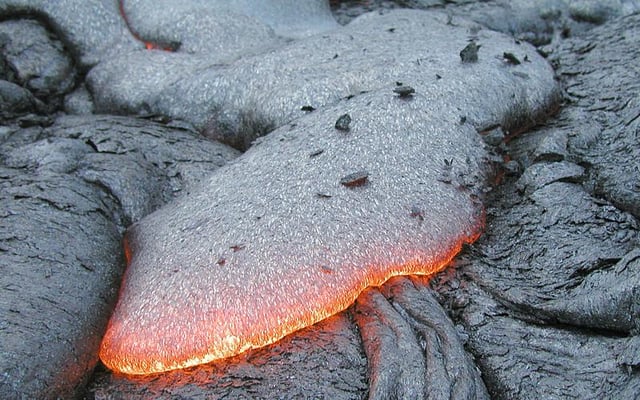
An active basalt lava flow
The shape, structure and texture of a basalt is diagnostic of how and where it erupted—whether into the sea, in an explosive cinder eruption or as creeping pāhoehoe lava flows, the classic image of Hawaiian basalt eruptions.
Subaerial eruptions
Basalt that erupts under open air (that is, subaerially) forms three distinct types of lava or volcanic deposits: scoria; ash or cinder (breccia); and lava flows.
Basalt in the tops of subaerial lava flows and cinder cones will often be highly vesiculated, imparting a lightweight "frothy" texture to the rock. Basaltic cinders are often red, coloured by oxidized iron from weathered iron-rich minerals such as pyroxene.
ʻAʻā types of blocky, cinder and breccia flows of thick, viscous basaltic lava are common in Hawaiʻi. Pāhoehoe is a highly fluid, hot form of basalt which tends to form thin aprons of molten lava which fill up hollows and sometimes forms lava lakes. Lava tubes are common features of pāhoehoe eruptions.
Basaltic tuff or pyroclastic rocks are rare but not unknown. Usually basalt is too hot and fluid to build up sufficient pressure to form explosive lava eruptions but occasionally this will happen by trapping of the lava within the volcanic throat and buildup of volcanic gases. Hawaiʻi's Mauna Loa volcano erupted in this way in the 19th century, as did Mount Tarawera, New Zealand in its violent 1886 eruption. Maar volcanoes are typical of small basalt tuffs, formed by explosive eruption of basalt through the crust, forming an apron of mixed basalt and wall rock breccia and a fan of basalt tuff further out from the volcano.
Amygdaloidal structure is common in relict vesicles and beautifully crystallized species of zeolites, quartz or calcite are frequently found.
Columnar basalt

The Giant's Causeway in Northern Ireland
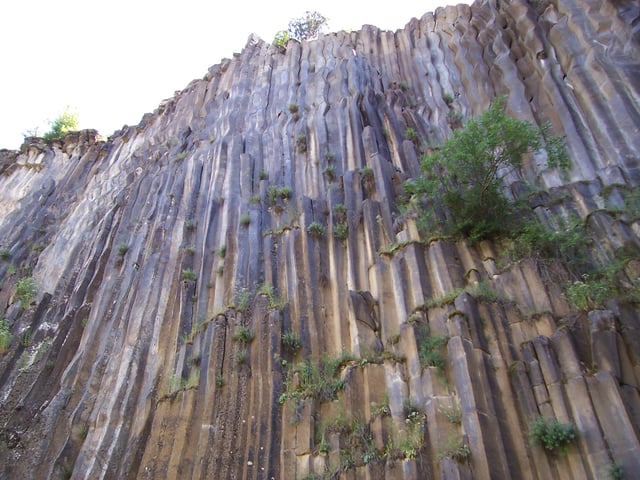
Columnar jointed basalt in Turkey
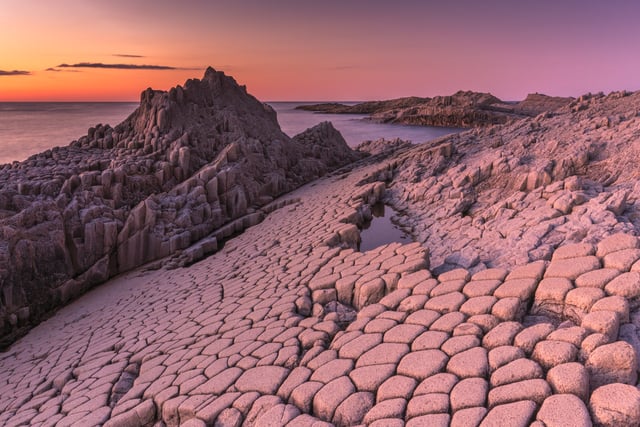
Columnar basalt at Cape Stolbchaty, Russia
During the cooling of a thick lava flow, contractional joints or fractures form.[21] If a flow cools relatively rapidly, significant contraction forces build up. While a flow can shrink in the vertical dimension without fracturing, it can't easily accommodate shrinking in the horizontal direction unless cracks form; the extensive fracture network that develops results in the formation of columns. The topology of the lateral shapes of these columns can broadly be classed as a random cellular network. These structures are predominantly hexagonal in cross-section, but polygons with three to twelve or more sides can be observed.[22] The size of the columns depends loosely on the rate of cooling; very rapid cooling may result in very small (<1 cm diameter) columns, while slow cooling is more likely to produce large columns.
Submarine eruptions
Pillow basalts
When basalt erupts underwater or flows into the sea, contact with the water quenches the surface and the lava forms a distinctive pillow shape, through which the hot lava breaks to form another pillow. This "pillow" texture is very common in underwater basaltic flows and is diagnostic of an underwater eruption environment when found in ancient rocks. Pillows typically consist of a fine-grained core with a glassy crust and have radial jointing. The size of individual pillows varies from 10 cm up to several meters.
When pāhoehoe lava enters the sea it usually forms pillow basalts. However, when ʻaʻā enters the ocean it forms a littoral cone, a small cone-shaped accumulation of tuffaceous debris formed when the blocky ʻaʻā lava enters the water and explodes from built-up steam.
The island of Surtsey in the Atlantic Ocean is a basalt volcano which breached the ocean surface in 1963. The initial phase of Surtsey's eruption was highly explosive, as the magma was quite fluid, causing the rock to be blown apart by the boiling steam to form a tuff and cinder cone. This has subsequently moved to a typical pāhoehoe-type behaviour.
Volcanic glass may be present, particularly as rinds on rapidly chilled surfaces of lava flows, and is commonly (but not exclusively) associated with underwater eruptions.
Pillow basalt is also produced by some subglacial volcanic eruptions.
Life on basaltic rocks
The common corrosion features of underwater volcanic basalt suggest that microbial activity may play a significant role in the chemical exchange between basaltic rocks and seawater. The significant amounts of reduced iron, Fe(II), and manganese, Mn(II), present in basaltic rocks provide potential energy sources for bacteria. Some Fe(II)-oxidizing bacteria cultured from iron-sulfide surfaces are also able to grow with basaltic rock as a source of Fe(II).[23] Fe- and Mn- oxidizing bacteria have been cultured from weathered submarine basalts of Loihi Seamount.[24] The impact of bacteria on altering the chemical composition of basaltic glass (and thus, the oceanic crust) and seawater suggest that these interactions may lead to an application of hydrothermal vents to the origin of life.
Distribution
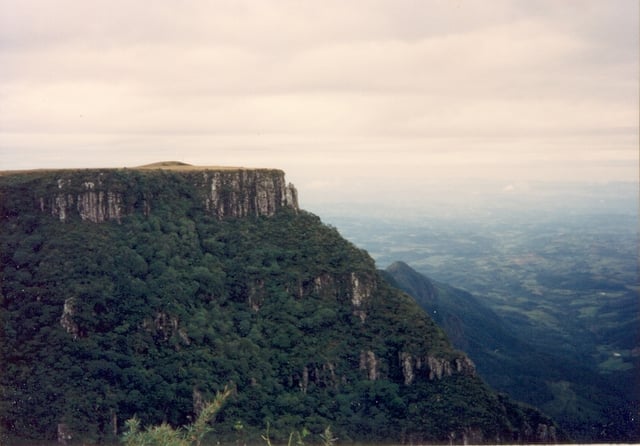
Paraná Traps, Brazil
The crustal portions of oceanic tectonic plates are composed predominantly of basalt, produced from upwelling mantle below, the ocean ridges.
Basalt is one of the most common rock types in the world. Basalt is the rock most typical of large igneous provinces. The largest occurrences of basalt are in the ocean floor that is almost completely made up by basalt. Above sea level basalt is common in hotspot islands and around volcanic arcs, specially those on thin crust. However, the largest volumes of basalt on land correspond to continental flood basalts. Continental flood basalts are known to exist in the Deccan Traps in India, the Chilcotin Group in British Columbia, Canada, the Paraná Traps in Brazil, the Siberian Traps in Russia, the Karoo flood basalt province in South Africa, the Columbia River Plateau of Washington and Oregon.
Many archipelagoes and island nations have an overwhelming majority of their exposed bedrock made up of basalt due to being above hotspots, for example, Iceland and Hawaiʻi.
Ancient Precambrian basalts are usually only found in fold and thrust belts, and are often heavily metamorphosed. These are known as greenstone belts, because low-grade metamorphism of basalt produces chlorite, actinolite, epidote and other green minerals.
Lunar and Martian basalt
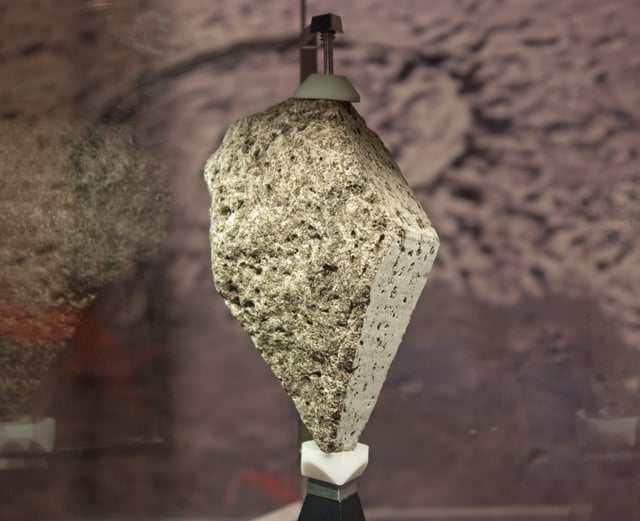
Lunar olivine basalt collected by Apollo 15.
The dark areas visible on Earth's moon, the lunar maria, are plains of flood basaltic lava flows. These rocks were sampled by the manned American Apollo program, the robotic Russian Luna program, and are represented among the lunar meteorites.
Lunar basalts differ from their Earth counterparts principally in their high iron contents, which typically range from about 17 to 22 wt% FeO. They also possess a wide range of titanium concentrations (present in the mineral ilmenite),[26] ranging from less than 1 wt% TiO2, to about 13 wt.%. Traditionally, lunar basalts have been classified according to their titanium content, with classes being named high-Ti, low-Ti, and very-low-Ti. Nevertheless, global geochemical maps of titanium obtained from the Clementine mission demonstrate that the lunar maria possess a continuum of titanium concentrations, and that the highest concentrations are the least abundant.[27]
Lunar basalts show exotic textures and mineralogy, particularly shock metamorphism, lack of the oxidation typical of terrestrial basalts, and a complete lack of hydration. Most of the Moon's basalts erupted between about 3 and 3.5 billion years ago, but the oldest samples are 4.2 billion years old, and the youngest flows, based on the age dating method of crater counting, are estimated to have erupted only 1.2 billion years ago.
Alteration of basalt
Metamorphism
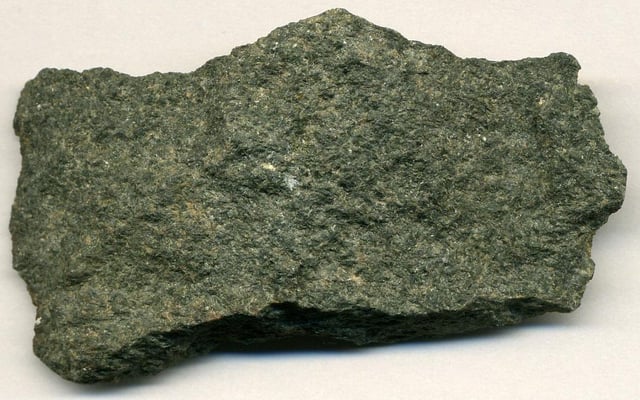
Metamorphosed basalt from an Archean greenstone belt in Michigan, US. The minerals that gave the original basalt its black colour have been metamorphosed into green minerals.
Basalts are important rocks within metamorphic belts, as they can provide vital information on the conditions of metamorphism within the belt.
Weathering
Compared to other rocks found on Earth's surface, basalts weather relatively fast. The typically iron-rich minerals oxidise rapidly in water and air, staining the rock a brown to red colour due to iron oxide (rust). Chemical weathering also releases readily water-soluble cations such as calcium, sodium and magnesium, which give basaltic areas a strong buffer capacity against acidification. Calcium released by basalts binds up CO2 from the atmosphere forming CaCO3 acting thus as a CO2 trap. To this it must be added that the eruption of basalt itself is often associated with the release of large quantities of CO2 into the atmosphere from volcanic gases.
Uses
Basalt is used in construction (e.g. as building blocks or in the groundwork), making cobblestones (from columnar basalt) and in making statues. Heating and extruding basalt yields stone wool, said to be an excellent thermal insulator.
Carbon sequestration in basalt has been studied as a means of removing carbon dioxide, produced by human industrialization, from the atmosphere. Underwater basalt deposits, scattered in seas around the globe, have the added benefit of the water serving as a barrier to the re-release of CO2 into the atmosphere.[29]
See also
Basalt fan structure – Rock formation composed of columnar jointed basalt columns that have slumped into a fan shape
Basalt fiber – Strucural fibres spun from melted basalt
Flood basalt – The result of a very large volume eruption of basalt lava
Igneous rock – Rock formed through the cooling and solidification of magma or lava
Mafic – Silicate mineral or igneous rock that is rich in magnesium and iron
Spilite – A fine-grained igneous rock, resulting from alteration of oceanic basalt
Sideromelane – A vitreous basaltic volcanic glass
Volcano – A rupture in the crust of a planetary-mass object that allows hot lava, volcanic ash, and gases to escape from a magma chamber below the surface